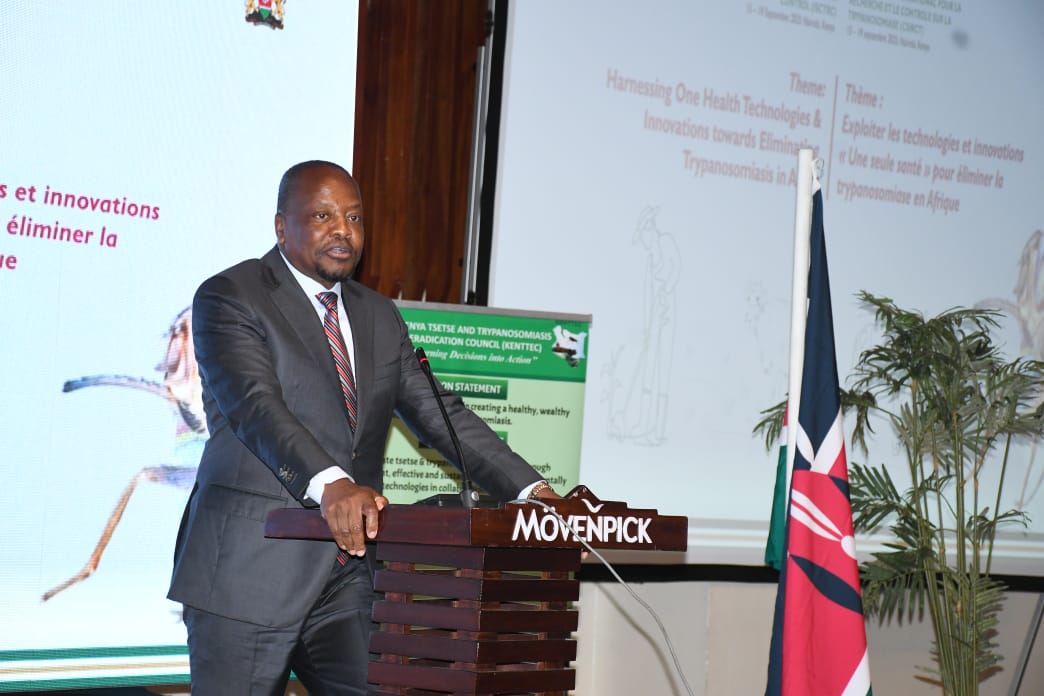
 Agriculture CS Mutahi Kagwe addresses scientists on Monday/HANDOUT
Agriculture CS Mutahi Kagwe addresses scientists on Monday/HANDOUTAgriculture Cabinet Secretary Mutahi Kagwe has challenged scientists to find ways to eradicate trypanosomiasis, saying the disease, together with the tsetse fly, is costing Kenya more than Sh18 billion every year.
Kagwe said Kenya is among the 38 African countries affected by the tsetse fly, with about 23 per cent of the landmass infested.
“This has
significant implications for our livestock and agricultural productivity,
particularly in the rangelands where over 70 per cent of our livestock
population is reared. The estimated annual loss due to tsetse and
trypanosomiasis in Kenya is around $143 million (Sh18.5 billion),” the CS said.
He made the remarks during the opening ceremony of the 37th International Scientific Council for Trypanosomiasis Research and Control Conference in Nairobi.
The theme of the weeklong conference is, ‘Harnessing One Health Technologies and Innovations Towards Eliminating Trypanosomiasis in Africa.’
Kagwe said the impact of the disease is felt across sub-Saharan Africa, and experts must work together to combat it as the challenge transcends boundaries, sectors and disciplines.
He said Kenya has been actively engaged in efforts to eradicate tsetse flies and trypanosomiasis through the Pan African Tsetse and Trypanosomiasis Eradication Campaign, a continental initiative coordinated by the African Union.
“We have made notable progress, and areas previously plagued by high tsetse and trypanosomiasis challenges can now support profitable agriculture,” he said.
Human African trypanosomiasis, also known as sleeping sickness, is a vector-borne parasitic disease.
It is caused by protozoans of the genus Trypanosoma, transmitted to humans by bites of tsetse flies (glossina), which have acquired the parasites from infected humans or animals.
Tsetse flies inhabit sub-Saharan Africa and only certain species transmit the disease.
Rural populations, which depend on agriculture, fishing, animal husbandry or hunting, are the most exposed.
Kagwe said Kenya made a significant milestone on June 16, when the World Health Organization validated the country as having eliminated Human African Trypanosomiasis, commonly known as sleeping sickness, as a public health problem.
He said the move was made possible through the collaborative efforts of Ministries of Health and Livestock Development and communities and development partners.
Kagwe said freeing the country’s rangelands from the tsetse menace would contribute significantly to the government’s Bottom-Up Economic Transformation Agenda of increased livestock productivity in the priority value chains of dairy, beef and leather hence improved livelihoods.
“It is in line with the global Sustainable Development Goals and the Africa Agenda 2063 on sustainable development, poverty eradication and improved living standards that we all cherish as partners.”
Dr Huyam Salih, the director of African Union's InterAfrican Bureau for Animal Resources, said
the conference convenes at a critical moment—when trypanosomiasis
continues to rob millions of livestock-dependent communities of their
livelihoods.
The disease is also denying employment to countless youth across the continent, contributing to malnutrition and stunting growth among African children due to poor livestock health and reduced productivity.
“While we
acknowledge the significant strides made in reducing sleeping sickness cases in
recent years, we must not be complacent. The disease still inflicts untold
suffering on many, and our mission is far from complete. My call to you today
is clear: we must accelerate our efforts,” Salih said.
“Let us unlock the power of collaboration and innovation, guided by the One Health—recognising the deep interconnection between livestock production, ecosystem integrity, climate change, public health, and the persistent challenge of trypanosomiasis.”
Salih said trypanosomiasis remains a formidable obstacle to sustainable agriculture, rural development and public health in numerous countries in Africa.
“Thirty-eight (38) out of 55 countries are affected by tsetse and trypanosomiasis. Fifty (50) million cattle are at risk of trypanosomiasis, resulting in an annual death toll of 3 million.”
Salih said the direct loses from reduced meat and milk production, treatment costs and vector control is estimated at $1.2 billion annually.
“The economic impact of trypanosomiasis on agricultural production is estimated at a staggering $5 billion annually across tsetse-infested regions. Trypanosomiasis also contributes to decreased draft power and fertility, which undermines food security and rural livelihood,” she added.
Salih said the human population exposed to the risk of trypanosomiasis was estimated at 6 million people in 2024.
“Human African Trypanosomiasis cases in 2024 were reported as 583 which is a drastic reduction of cases experienced earlier of 28,000 cases in 1999. The reduction reflects decades of coordinated surveillance, treatment innovation and vector control efforts across endemic regions,” she added.
Salih cited a number of challenges associated with trypanosomiasis control and elimination in the African continent.
They include fragmented institutional coordination as evidenced by lack of synergy between veterinary, medical and environmental sectors undermining sustainable and effective control and elimination efforts.
Inadequate and unsustainable funding with control programmes relying heavily on donor support, inadequate community involvement, climate change and land-use shifts and parasite resistance to drugs and insecticide resistance in tsetse populations are other challenges.
















